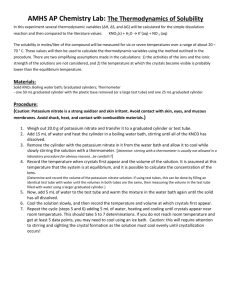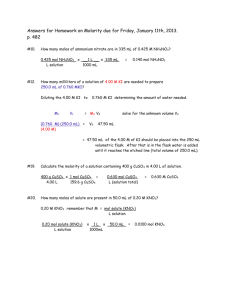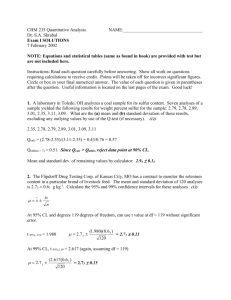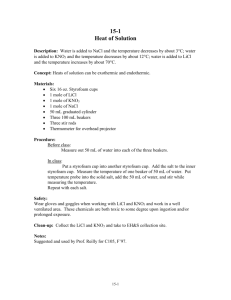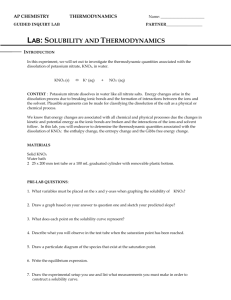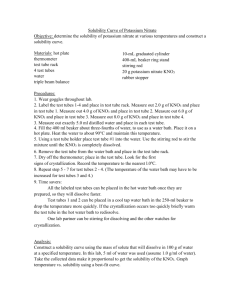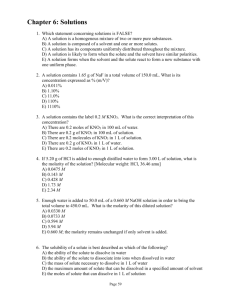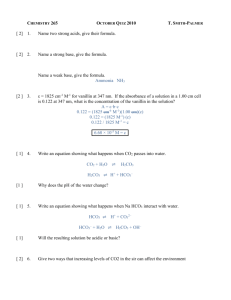KNO3 Thermodynamics Lab: ΔG, ΔH, ΔS Determination
advertisement
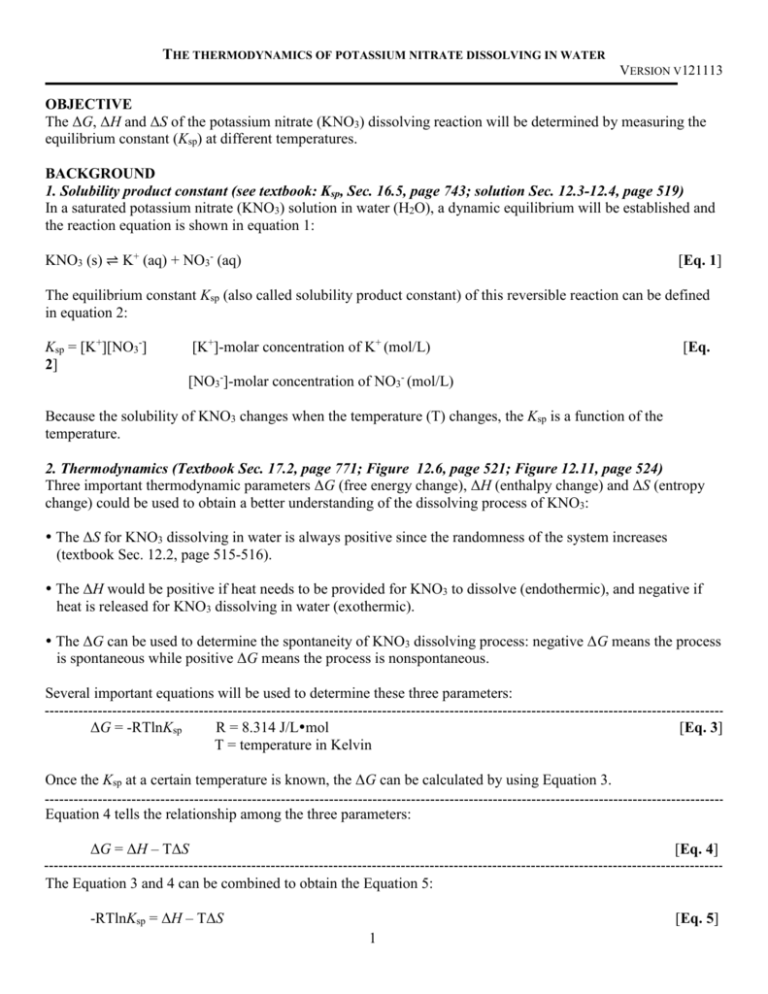
THE THERMODYNAMICS OF POTASSIUM NITRATE DISSOLVING IN WATER VERSION V121113 OBJECTIVE The ΔG, ΔH and ΔS of the potassium nitrate (KNO3) dissolving reaction will be determined by measuring the equilibrium constant (Ksp) at different temperatures. BACKGROUND 1. Solubility product constant (see textbook: Ksp, Sec. 16.5, page 743; solution Sec. 12.3-12.4, page 519) In a saturated potassium nitrate (KNO3) solution in water (H2O), a dynamic equilibrium will be established and the reaction equation is shown in equation 1: KNO3 (s) ⇌ K+ (aq) + NO3- (aq) [Eq. 1] The equilibrium constant Ksp (also called solubility product constant) of this reversible reaction can be defined in equation 2: Ksp = [K+][NO3-] 2] [K+]-molar concentration of K+ (mol/L) [Eq. [NO3-]-molar concentration of NO3- (mol/L) Because the solubility of KNO3 changes when the temperature (T) changes, the Ksp is a function of the temperature. 2. Thermodynamics (Textbook Sec. 17.2, page 771; Figure 12.6, page 521; Figure 12.11, page 524) Three important thermodynamic parameters ΔG (free energy change), ΔH (enthalpy change) and ΔS (entropy change) could be used to obtain a better understanding of the dissolving process of KNO3: The ΔS for KNO3 dissolving in water is always positive since the randomness of the system increases (textbook Sec. 12.2, page 515-516). The ΔH would be positive if heat needs to be provided for KNO3 to dissolve (endothermic), and negative if heat is released for KNO3 dissolving in water (exothermic). The ΔG can be used to determine the spontaneity of KNO3 dissolving process: negative ΔG means the process is spontaneous while positive ΔG means the process is nonspontaneous. Several important equations will be used to determine these three parameters: ΔG = -RTlnKsp R = 8.314 J/Lmol T = temperature in Kelvin [Eq. 3] Once the Ksp at a certain temperature is known, the ΔG can be calculated by using Equation 3. Equation 4 tells the relationship among the three parameters: ΔG = ΔH – TΔS [Eq. 4] The Equation 3 and 4 can be combined to obtain the Equation 5: -RTlnKsp = ΔH – TΔS [Eq. 5] 1 Reorganization of Equation 5 yields Equation 6, which shows the linear relationship between lnKsp and 1/T: ΔH 1 ΔS lnKsp = − ( ) ( ) + R T R [Eq. 6] Therefore, a plot of lnKsp versus 1/T yields a straight line with a slope of –ΔH/R and a y-intercept of ΔS/R. So the ΔH and ΔS can be calculated based on the linear equation obtained from the linear fitting of the graph. The second way to calculate the ΔS is by using Equation 4. Once ΔG and ΔH are known from Equation 3 and the slope of the linear graph, ΔS can be calculated with temperature in Kelvin. 3. Examples Example 1. At 0°C, one liter of saturated KIO3 solution can be prepared by dissolving 46.0 g KIO3 in water. Determine the Ksp of KIO3 at 0°C. Step 1. Calculate the concentration of KIO3 1 𝑚𝑜𝑙 1 46.0 g × 214.0 𝑔 × 1 𝐿= 0.215 mol/L Step 2. Calculate the Ksp Equation 1 shows one equivalent of KIO3 will disassociate to one equivalent of K+ and one equivalent of IO3-, therefore both concentrations of K+ and IO3- are 0.215 mol/L. Ksp = [K+][IO3-] = 0.215 × 0.215 = 0.0462 Example 2. Determine the ΔG based on the Ksp from the Example 1. According to Equation 3: ΔG = -(8.314 J/Kmol)(0°C + 273 K)(ln0.0462) = 6980 J/mol Example 3. Determine the ΔH and ΔS based on the data from the following table. Temperature (K) 1/T (K-1) Ksp 273 0.00366 0.0462 293 0.00341 0.143 373 0.00268 2.28 lnKsp -3.07 -1.94 -0.824 Plot the lnKsp vs 1/T and fit the data. The equation shows the slope and y-intercept as -2120 and 4.945, respectively. y = -2120 × x + 4.945 R2 = 0.9241 2 Therefore, based on Equation 6: -2120 K = - 𝛥𝐻 𝑅 =- 𝛥𝐻 8.314 𝐽/𝐾𝑚𝑜𝑙 ΔH = 2120 K × 8.314 J/Kmol = 1.763 × 104 J/mol Since ΔS/R is the y-intercept in Equation 6: 4.945 = 𝛥𝑆 𝑅 = 𝛥𝑆 8.314 𝐽/𝐾𝑚𝑜𝑙 ΔS = 4.945 × 8.314 J/Kmol = 41.13 J/Kmol Example 4. The second method to calculate ΔS is from Equation 4. For instance, since the values ΔG and ΔH are available from the calculation of example 2 and 3, the ΔS at 0°C can be calculated as the following: ΔG = ΔH – TΔS ΔS = Δ𝐻− Δ𝐺 T = 17630 J/mol−6890 J/mol 273 𝐾 = 39.34 J/Kmol PROCEDURE ~~~~~~~~~~~~~~~~~~~~~~~~~~~~~~~~~~~~~~~~~~~~~~~~~~~~~~~~~~~~~~~~~~~~~~~~~~~~~ Safety Wear departmentally approved eyewear while doing this experiment. Do not ingest any solids or solutions as glassware may be contaminated with other chemicals. Clean the spilled KNO3 solid around balance and KNO3 solution on bench after you finish the lab. ~~~~~~~~~~~~~~~~~~~~~~~~~~~~~~~~~~~~~~~~~~~~~~~~~~~~~~~~~~~~~~~~~~~~~~~~~~~~~ Chemical Hazards KNO3 – oxidant and irritant ~~~~~~~~~~~~~~~~~~~~~~~~~~~~~~~~~~~~~~~~~~~~~~~~~~~~~~~~~~~~~~~~~~~~~~~~~~~~~ 1. Assemble a hot water bath for KNO3 dissolving as shown in Figure 1. 2. Measure about 20 g of KNO3 on a balance. Record the exact mass of KNO3 and transfer the compound to a dry clean 200 mL test tube. Thermometer Stirring rod 3. Measure 15 mL of distilled water and add it to the test tube with KNO3. Heat the tube in water bath with the hot plate and stir the mixture with a metal wire rod until all of the KNO3 dissolves. KNO3 solution in test tube Hot water bath Hot plate Figure 1. Setup for heating the KNO3 in test tube. 4. Remove the test tube from the hot water bath and use paper towel to dry the outer wall of the test tube quickly (Figure 2A). Lift the septa with the thermometer and stirring rod gently until the thermometer bulb stays right above the solution level (Figure 2B). Note: Don’t remove the septa with the thermometer completely from the test tube. 3 A B C Figure 2. Lift the thermometer and mark the KNO3 solution level (step 4 and 5). 5. Mark the solution level on the test tube with a sharpie and label it as 1 (Figure 2C). Replace the septa with the thermometer and let the test tube with KNO3 solution cool naturally while slowly stirring the solution. 6. Observe the KNO3 solution when it cools and record the temperature when the first white crystal appears. This will be the temperature for the equilibrium in Equation 1. 7. Add 5 mL of distilled water to the test tube after you record the temperature. Put the test tube back to hot water bath and heat it until all KNO3 dissolves. Repeat step 4, 5 and 6 to mark the solution level as 2 and record the equilibrium temperature. 8. Repeat step 7 two more times and collect the data for the 3rd and 4th trials. 9. After you finish all four trials, there should be four markers on the 200 mL test tube labeled as 1, 2, 3 and 4. Determine the solution volumes at each mark. Add tap water to the tube up to the first mark. Pour this water into a 100 mL graduate cylinder and record the volume. Repeat the procedure for each of the remaining marks on the tube, and measure the remaining volumes. 10. When the experiment is finished, disposal the KNO3 solution into the waste container in the fume hood and clean the glassware. 4 Name(s)_________________________________________ Section____________ Date__________ DATA SHEET 1. Mass of KNO3 (g)______________ Moles of KNO3 (mol)______________ 2. Calculation: Calculation of ΔG (kJ/mol) from Ksp Trial 1 Trial 2 Trial 3 Total volume (mL) Concentration (M) of [KNO3] = [K+] = [NO3-] Ksp = [K+][NO3-] Temperature(°C) when white crystal forms Temperature(K) when white crystal forms ΔG = -RTlnKsp (Eq. 3) Calculation of ΔH (kJ/mol) and ΔS (J/Kmol) 1/T (K-1) Linear fitting equation from the graph R2 value of the linear fitting Slope of the line ΔH (kJ/mol) Calculation of ΔS (J/Kmol) (method 1 based on Equation 6) y intercept of the linear line ΔS (J/Kmol) Calculation of ΔS (J/Kmol) (method 2 based on Equation 4 ΔG = ΔH – TΔS) ΔS (J/Kmol) Average ΔS (J/Kmol) 5 Trial 4 Name(s)_________________________________________ Section____________ Date__________ Pre-Lab Questions 1. How do you determine whether a solution is saturated or not? 2. The equilibrium of a saturated LiCl aqueous solution is shown below: LiCl (s) ⇌ Li+ (aq) + Cl- (aq) At 20°C, the solubility of LiCl in water is 550.0 g/L. (a) Calculate the molar concentration of LiCl. (b) Calculate the molar concentration of Li+ and Cl-. (c) Calculate the Ksp for LiCl at 20°C. 3. The equilibrium of a saturated NaF aqueous solution is shown below: 6 NaF (s) ⇌ Na+ (aq) + F- (aq) The following table shows the solubility of NaF at different temperatures. Temp (°C) Ksp 0 0.751 20 0.925 100 1.446 Temp (K) 1/T (K-1) lnKsp ΔG (J/mol) (a) Complete the entries in the table. (b) Plot the lnKsp as a function of 1/T. Fit the data and determine the slope of the line. (c) Calculate the ΔH and ΔS. Name(s)_________________________________________ Section____________ Date__________ 7 Post-Lab Questions 1. Is the KNO3 dissolving process spontaneous or nonspontaneous? Please explain based on your data. 2. (a) Is the KNO3 dissolving process exothermic or endothermic? Please explain based on your data. (b)Which picture (a or b) in Figure 12.6 (page 521 of textbook) matches with your observation and calculation results on ΔH? Please explain based on your data. (c) Figure 12.11 (page 524) shows the temperature-dependent solubility of KNO3. Does your data match the trend of the curve? Na2SO4 shows a different trend in solubility when temperature changes in Figure 12.11. What does it mean about ΔH? 8 3. Is your ΔS for KNO3 positive or negative? What does it mean? 4. During the lab, each time when you add more water to the test tube, you have to wait longer time to get precipitation of KNO3. Why? 9

